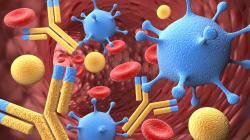Antibodies from COVID-19 or Vaccination Target SARS-CoV-2 Variants
Serum neutralizing antibodies to SARS-CoV-2 from infection or vaccination were found to recognize and act against new variants of the virus.

Antibodies against SARS-CoV-2 that are generated from either COVID-19 infection or vaccination can recognize and act against new variants of the virus, according to a new research letter in JAMA.
"The emergence of SARS-CoV-2 variants has raised concerns about the breadth of neutralizing antibody responses," observe Venkata Edara, PhD, Emory University Department of Pediatrics, Atlanta, GA, and colleagues.
"We compared the neutralizing antibody response to 4 variants in infected and vaccinated individuals to determine how mutations within the spike protein are associated with virus neutralization," they indicate.
The investigators conducted live-virus focus reduction neutralization tests (FRNTs) of antibodies obtained from patients within 5 to 19 days of PCR-confirmed acute COVID-19 (n=20), from those whose serum samples were drawn from 32 to 94 days after symptom onset and with PCR or antigen test confirmation (n=20), and from serum samples drawn from individuals (n=14) 14 days after their second dose of an m-RNA vaccine.
The antibodies were tested against 4 variants. One, nCoV/USA_WA1/2020 (A.1 lineage), resembled the original Wuhan strain, with the spike used in mRNA1273 vaccine.It was propagated from an infectious SARS-CoV-2 clone.A second, EHC-083E (B.1 lineage), contained the D614G mutation within the spike and was the predominant circulating strain at the time of the study.It was isolated by nasopharyngeal swab from a patient in Atlanta. The third, B.1.1.7 (SARS-CoV-2/human/USA/Ca_CDC_5574/2020, was the variant initially identified in the UK that has appeared to have increased transmissibility. It was isolated by nasopharyngeal swab from a patient in California.
A fourth variant, N501Y SARS-CoV-2, was developed with an infectious clone to contain a mutation in the critical receptor binding domain of the spike that is conserved across multiple emerging variants, including the B.1.1.7 variant.
The FRNT50 titers, Edara and colleagues explain, represent the reciprocal dilution of serum that neutralizes 50% of the introduced virus.They calculated the following geometric mean titers (GMTs) between variants—with the 95% Confidence Intervals omitted here.They found neutralizing activity across variants, with no statistical differences in FRNT50 GMT titers between variants within the acute COVID-19 and the convalescent patient groups.
From acutely infected patients (mean age 56.6 years), FRNT50 GMT was 186 for A.1; 110 for B.1; 116 for B.1.17; and 141 for N501Y. In samples from convalescent individuals (mean age 45 years), FRNT50 GMT was 168 for the A.1 variant; 91 for B.1; 145 for B.1.1.7; and 145 for N501Y.
For antibodies generated in vaccinated individuals (age range 18-55 years), FRNT50 GMT was 1709 for A.1; 804 for B.1; 965 for B.1.1.7; and 994 for N401Y.The antibody response from vaccination appeared more robust across variants than from prior infection; but with the FRNT50 GMTs for the B.1 and B.1.1.7 statistically significantly lower than against the A.1 variant.
While acknowledging that the study design is without clinical outcomes, and does not correlate neutralization titers with protection, the investigators nevertheless indicate that the results suggest that prior antibody generation could provide protection against a concerning variant.
"Because neutralization studies measure the ability of antibodies to block virus infection, these results suggest that infection- and vaccine-induced immunity may be retained against the B.1.1.7 variant," Edara and colleagues concluded.
